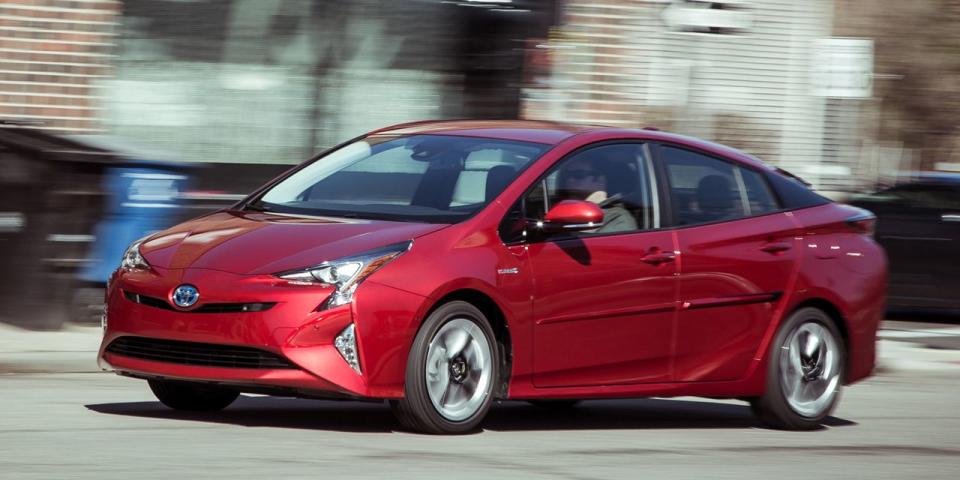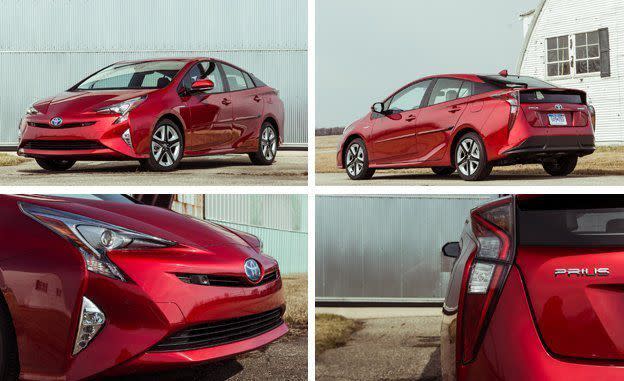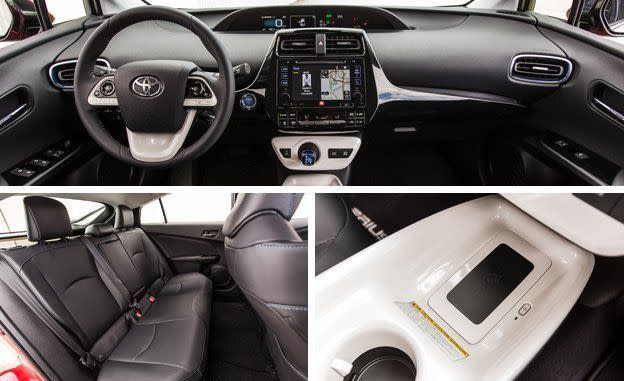2016 Toyota Prius Four Touring

Back in 2004, the Toyota Prius earned a spot on our 10Best Cars list. It didn’t offer any of the dynamic virtues that normally get us excited, but the second-generation Prius entertained us in a different way with its video-game-like efficiency displays. We surprised ourselves by finding enjoyment in feathering the throttle to minimize using the gasoline engine, thereby reaching those magic 50-plus-mpg numbers.
Feel the TNGA
Twelve years later, in a world of cheap gasoline, the hypermiling shtick is wearing off. With the fourth generation of its iconic hybrid, Toyota now promises improved road manners due in part to a Toyota New Global Architecture (TNGA) that underpins the eco-mobile. Its lower center of gravity and more sophisticated suspension aim to improve the ride and handling, never a Prius strong suit.

The new chassis really does make for a better-driving hybrid. The rear suspension, with an independent trailing-arm setup in place of the previous torsion-beam axle, delivers a more controlled ride. Impacts are soaked up with little noise or reverberation from the car’s structure, although we did notice that the low-rolling-resistance tires create a fair amount of road noise at highway speeds. The car also turns in more sharply than the last Prius, and the steering—while still numb and uncommunicative—is decently weighted and more accurate than before. Our main complaint with the driving experience is still the vague, unpredictable feel from the brake pedal. You’d think that Toyota, with more experience in hybrids than any other automaker, would have figured out the blending of regenerative and friction braking by now. It hasn’t.
Compared with the Two Eco model we tested earlier this year, this top-of-the-line Prius Four Touring was loaded with equipment like navigation, faux-leather seats, a park-assist system, and Toyota’s active safety suite (coined Safety Sense P) that includes adaptive cruise control, forward-collision warning, and lane-keeping assist. It also had larger, 17-inch wheels and wider 215-millimeter tires instead of the base Prius’s 15/195 configuration. But if there’s a benefit to these upgrades, it’s purely cosmetic. In fact, this Touring model managed only 0.79 g on the skidpad, less grip than the Eco’s 0.84 g. The Touring’s braking distance also was slightly worse, taking 179 feet to stop from 70 mph compared with the Eco’s 175 feet. Some of the disparity is surely attributable to differences between the Touring’s Bridgestone Ecopia rubber and the Eco’s Dunlop Enasave tires as well as to the extra 85 pounds that the higher-trim Prius Four Touring carries.
The test track also revealed a slower zero-to-60-mph acceleration run, with the Touring doing the deed in 10.5 seconds, 1.1 seconds behind the Eco. Like all Priuses before it, the new version doesn’t enjoy being hurried. When you call for more urgent thrust, as when merging onto the highway, the 1.8-liter four-cylinder drones unpleasantly and strains to get up to speed. At least the electric motor has decent midrange torque at lower speeds to help get around slower traffic in city and suburban driving.
Mileage Matters
What about fuel economy, the Prius’s reason for being? We averaged 44 mpg over the car’s stay with us. In the Eco model, by contrast, we managed 47 mpg, making our results roughly proportional to the EPA’s combined ratings: 56 mpg for the Eco and 52 mpg for the other Prius models. Go easy on the car, and 50 mpg is easily achievable around town—and even possible at near-80-mph highway speeds—although hitting the 54-mpg city rating seems like it would take ideal weather (to avoid A/C usage), a gentle right foot, and a close monitoring of the energy-flow displays to maximize time spent in EV mode.

Those energy displays, which can be shown on either the 4.2-inch screen next to the digital speedometer or the main 6.1-inch central display (or both simultaneously), are extra useful in this latest Prius because the revised gas-electric drivetrain works even more smoothly than before. You’ll hardly notice as the car trades off power delivery between the gasoline engine and the electric motor. This new Prius also runs in electric-only mode more often than we remember from past generations (at least in warmer temperatures).
Carpooling commuters will also benefit from the Prius’s superb interior packaging. As a device for carrying people and stuff, the Prius excels. Rear-seat passengers enjoy adequate legroom and headroom, along with nicely sculpted seat cushions. Opening the liftgate reveals a low, flat cargo floor, and the 60/40-split rear seats fold easily to expand the 27-cubic-foot cargo hold to a crossover-like 66 cubic feet. With the seats down, the Prius easily fits a bicycle without having to remove a wheel.
The well-padded front seats are a pleasant place to spend time. Aside from ergonomic oddities like the stubby gear lever and the hard-to-reach seat-heater controls below the center stack, the Prius’s control layout functions well. The simple climate controls are set apart from the infotainment system, which is operated by a responsive touchscreen flanked by volume and tuning knobs. Even though the seating position is low, the large glass area affords clear visibility, at least out front. The tailgate’s split-window design and the large C-pillars compromise the rear view, offset by the standard backup camera and the available blind-spot warning system.
You might notice that we haven’t yet mentioned the new Prius’s polarizing looks. Toyota created the idea that a hybrid shouldn’t look like a conventional car, and it has gone all-in with this Prius’s angular front and rear fascias and tortured curves. We’re less perturbed by the awkward styling than we were when the car first debuted, and certain details such as the rear end’s vertical LED light bars are cool and distinctive. You have probably already decided what you think of it.
For our loaded test car’s $33,708 asking price, some of the interior plastics—notably the white trim pieces on the steering wheel and center console—look and feel cut-rate. But there’s plenty of storage space for your phone, keys, and other accoutrements, and the materials would be more passable in a lower-trim Prius Two or Three model, either of which stickers for less than $30,000.
Viewed on its own, there’s plenty to like about the Prius’s combination of space and efficiency, and its advanced powertrain is an impressive technological feat. It’s undoubtedly the best Prius yet, and it will please efficiency enthusiasts more than ever. But it’s not hard to think of small cars we’d rather drive, such as the new Honda Civic or the 10Best Cars–winning Mazda 3 and Volkswagen Golf. Granted, none of those cars can deliver 44 mpg, but each is a whole lot more fun and costs thousands of dollars less than a comparable Prius. Despite its improvements, the latest version of Toyota’s iconic hybrid continues to define its niche, while still falling short of more mainstream alternatives on dynamics.
You Might Also Like

 Yahoo Autos
Yahoo Autos 